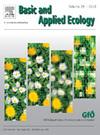The extended role of carrion: Insect consumption and hair taking at fox carcasses
IF 3.5
2区 环境科学与生态学
Q2 ECOLOGY
引用次数: 0
Abstract
Scavenging has been profusely studied in the last decades. However, carrion is more than a direct source of food for scavengers and decomposers, as it may provide many non-scavenging ecological functions. These include the provision of carrion insects to insectivores and hair to nest-building species. However, the patterns of use of these resources are greatly unknown. In this context, carnivore carcasses may represent an outstanding study model because they usually persist in the environment for longer than herbivore carcasses. Here, we used video-trapping to explore the consumption of carrion insects and hair taking at 99 red fox (Vulpes vulpes) carcasses in three areas of southeastern Spain. Carcasses were frequently used for consuming insects and taking hair (7.3 events in total on average per carcass). These non-scavenging behaviors were observed over eight weeks for most carcasses, peaking around the fifth week. Birds were the main users of carcasses, distantly followed by mammals; reptiles were only recorded feeding occasionally on carrion insects. These behaviors were more frequent during spring, when the demand for insects for offspring feeding and hair for nest building is maximized by many vertebrates. Moreover, the community of species exhibiting each of these behaviors was highly organized, as evidenced from their nested structure. We observed co-occurrence of insect consumption and hair taking in a quarter of carcasses, with co-occurrence being mostly due to chance and certain individuals and groups that used some carcasses for both purposes. Overall, non-scavenging uses of fox carcasses by vertebrates in our study area is more frequent than scavenging, which highlights the broad ecological relevance of carnivore carcasses and opens exciting future research avenues.
腐肉的扩展作用:吃掉狐狸尸体上的昆虫和毛发
在过去的几十年里,人们对食腐进行了大量的研究。然而,腐肉不仅仅是食腐动物和分解者的直接食物来源,因为它可能提供许多非食腐生态功能。这些包括为食虫动物提供腐肉昆虫和为筑巢物种提供毛发。然而,这些资源的使用模式是非常未知的。在这种情况下,食肉动物的尸体可能是一个杰出的研究模型,因为它们通常比食草动物的尸体在环境中存活的时间更长。在这里,我们使用视频诱捕法来探索西班牙东南部三个地区99只赤狐(Vulpes Vulpes)尸体的腐肉昆虫和毛发的消耗。尸体经常被用来吃昆虫和取毛(平均每具尸体共7.3次)。这些非食腐行为在大多数尸体的八周内被观察到,在第五周左右达到顶峰。鸟类是尸体的主要使用者,哺乳动物紧随其后;据记载,爬行动物只是偶尔吃腐肉昆虫。这些行为在春季更为频繁,因为许多脊椎动物对昆虫的需求最大,需要昆虫来喂养后代,需要毛发来筑巢。此外,表现出这些行为的物种群落是高度组织化的,这从它们的巢结构中可以得到证明。在四分之一的尸体中,我们观察到吃虫和取毛的现象同时发生,这种现象主要是由于偶然和某些个体和群体同时使用一些尸体来达到这两种目的。总的来说,在我们的研究区域,脊椎动物对狐狸尸体的非食腐性利用比食腐性更频繁,这突出了食肉动物尸体广泛的生态相关性,并开辟了令人兴奋的未来研究途径。
本文章由计算机程序翻译,如有差异,请以英文原文为准。
求助全文
约1分钟内获得全文
求助全文
来源期刊

Basic and Applied Ecology
环境科学-生态学
CiteScore
6.90
自引率
5.30%
发文量
103
审稿时长
10.6 weeks
期刊介绍:
Basic and Applied Ecology provides a forum in which significant advances and ideas can be rapidly communicated to a wide audience. Basic and Applied Ecology publishes original contributions, perspectives and reviews from all areas of basic and applied ecology. Ecologists from all countries are invited to publish ecological research of international interest in its pages. There is no bias with regard to taxon or geographical area.
 求助内容:
求助内容: 应助结果提醒方式:
应助结果提醒方式:


